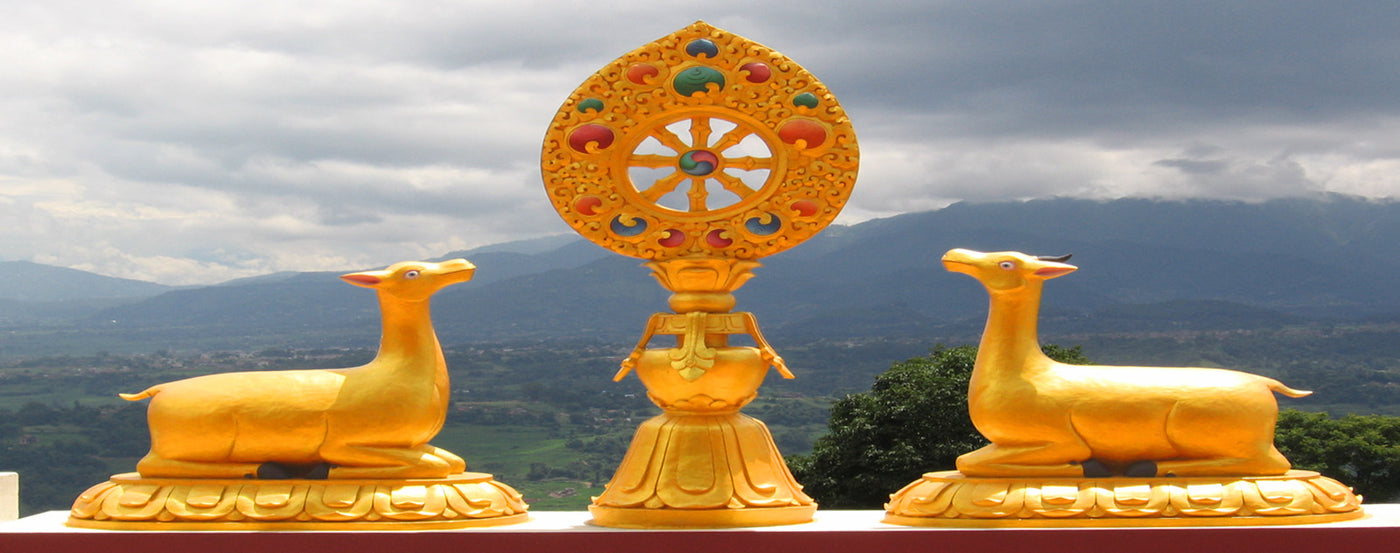Your Cart is Empty
🙏 La livraison est offerte sur tous vos achats ! 🙏

The Dharma Wheel, Dharmachakra, or Dharma Wheel, is one of the many sacred teachings of Buddhism and other Indian religions, such as Hinduism and Jainism. It is one of the most important and sacred symbols of the Buddhist faith because it represents the teachings of the Buddha.

Dharmachakra comes from Dharma, which is the path to attain enlightenment and to attain Nirvana (the highest state that a person can attain). It also means the Wheel of Law.
There are many variations of the Dharma wheel, they are usually depicted with eight spokes and are gold in color. Three shapes are represented at the center of the wheel, typically a Yin Yang shape, a wheel, or a circle.
The meaning of Dharmachakra generally relates to a typical Dharma wheel with eight spokes - representing the eightfold path - and is the oldest universal symbol for Buddhism. There are multiple ways of interpreting the Wheel of Dharma, so there are multiple meanings behind the symbol. There are three different parts that make up the Dharma wheel: the spokes, the hub, and the rim.

The edge of the Dharma Wheel further signifies the ability to hold all the teachings together by meditating and focusing. The circular shape of the wheel symbolizes the perfection of Buddha's teachings.
The hub in the center of the Dharma wheel represents moral discipline. The three swirling shapes on the hub, often depicted in blue, yellow, and red, symbolize Dharma, Buddha, and Sangha respectively. They are also known as the Three Treasures or Jewels.
A Dharma wheel with four spokes symbolizes the four noble truths. The wheel has eight spokes, it represents the eightfold path and Buddhism. Ten spokes on a Dharma wheel signify the ten directions and twelve spokes symbolize the Twelve Links of Dependent Origin.

If a Dharma wheel has twenty-four spokes, it is known as Ashoka chakra and symbolizes the twenty-four ideal qualities of a disciple of Buddhism. The Ashoka chakra also represents the reversal of the Twelve Links and the liberation of Samsara - the continuous cycle of reincarnation. A Dharma wheel with thirty-one spokes represents the thirty-one realms of existence found in Buddhist cosmology.
In its entirety, the Dharma Wheel symbolizes the teachings of Buddha. When one practices Dharma, one practices the teachings of the Buddha, one protects oneself from suffering and one eliminates ignorance, thus improving one's quality of life.
These teachings have been described as a wheel because they move and travel across the land and people can then exercise control over their minds. Together, the three aspects of the Dharma Wheel symbolize focus, ethics and wisdom - all of which are essential in the teachings of the Buddha.

One of the oldest representations of the Dharma Wheel as a symbol has been found on the pillars which were built by Emperor Ashoka between 304 and 232 BC. He reigned over India and followed the teachings of Buddhism.
Several of the pillars he built are still standing today and represent various edicts that encouraged his people to practice Buddhism, without ever forcing them. Ashoka Chakras, Dharma wheels with twenty-four spokes, can be found on these pillars.

However, the Dharma Wheel appeared in Indian artwork before the reign of Ashoka the Great.These Dharma wheels also had twenty-four spokes and appeared to rest on four lions that sat back to back as they each faced one of the four cardinal points

In 1947, the Ashoka chakra became part of the Indian flag. Today, the Dharma wheel is represented in art within different Buddhist cultures. This can be seen in the images of Buddha as they appear on his hands and feet - depicting one of the Marks of a Great Man.

The meaning of Dharmachakra in Hinduism refers more to the Wheel of Dharma as the Wheel of Law. It is a symbol of order and religious routine that the pious Hindu devotees must practice. In Sanskrit, the word Dharma comes from the word dhr, which means "to hold and maintain" and "that which is established or close ".
The Dharma Wheel is commonly found in representations of Vishnu, the god of preservation. Vishnu is one of the Hindu triumvirates and is the god responsible for the protection of humans as well. that of restoring and maintaining order in the world. He is often depicted carrying a wheel or disc, which is considered to be a very powerful weapon that can conquer passions and desires.

In Tibet, the Dharma wheel is a very important symbol because it is one of the eight auspicious symbols. It is typically seen between two deer, which symbolizes the early teachings of Buddha in a deer park. When Buddha gave this first sermon, the deer in the park gathered and listened. When deer are depicted next to a Dharma wheel, it serves as a reminder that Buddha has valued all beings and the whole world. life, not just humans.
In these performances, the Dharma wheel must be twice as high as the deer as they sit peacefully beside them with their legs tucked under them and their heads raised to look at the wheel.

Some Tibetan deities are depicted using the wheel as a weapon to overcome evil and ignorance. These depictions are believed to have been influenced by Hindu depictions of the Lord Vishnu who also carries the wheel as a weapon.

The Dharma Wheel is a sacred and ancient Buddhist symbol and represents the Buddhist faith universally. After attaining enlightenment, Buddha gave his first teachings and delivered a sermon on the first Dharma wheel. He gave this sermon in a deer park in Sarnath, Uttar Pradesh, India.
Buddha spoke about the Sutra of the Four Noble Truths, the Perfection of the Wisdom Sutras and the Sutra Discriminating Intention. These three teachings are known as the Three Turns of the Dharma Wheel.
Comments will be approved before showing up.